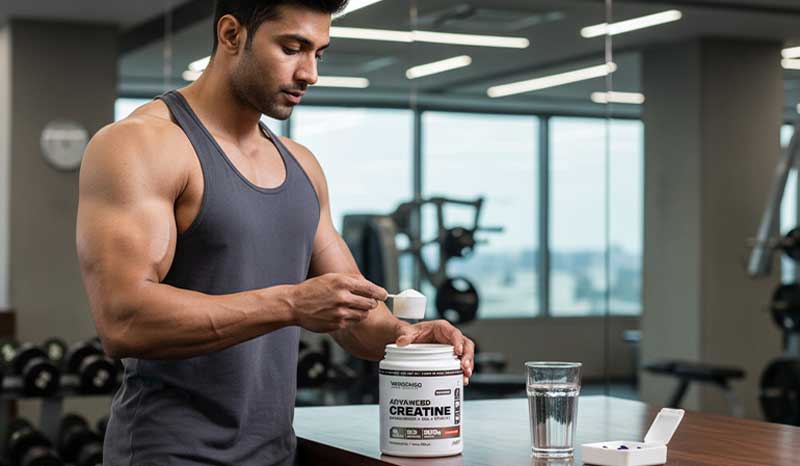Does Creatine Increase Muscle Size? Expert Guide
Creatine - If you’ve ever stepped into a gym in India or browsed fitness forums online, chances are you’ve heard about creatine.
Marketed as one of the most effective supplements for muscle growth and strength, creatine has sparked countless debates among fitness enthusiasts.
But the burning question remains: does creatine actually increase muscle size?
In this guide, we’ll explore everything you need to know about creatine, how it works, and its role in boosting muscle mass.
Creatine and How It Works?
Creatine is a naturally occurring compound found in small amounts in meat and fish, and it is also produced by the body in the liver, kidneys, and pancreas.
In the muscles, creatine combines with phosphate to form phosphocreatine, a molecule that helps regenerate ATP (adenosine triphosphate), the primary energy source for high-intensity activities like weightlifting or sprinting.
By increasing the availability of ATP, creatine allows your muscles to perform better during short bursts of intense exercise.
This increase in performance indirectly contributes to muscle growth over time, making it one of the most researched and trusted supplements in sports nutrition.
Creatine and Muscle Size: The Science
Yes, creatine can increase muscle size by boosting water retention in muscles and supporting strength gains over time.
Multiple studies have shown that creatine supplementation can lead to measurable gains in muscle mass and strength.
When you take creatine regularly, your muscles retain more water, which makes them appear fuller and larger.
This is sometimes called “cell volumization,” and it also signals muscle cells to boost protein synthesis, the process responsible for muscle repair and growth.
Research conducted over the years has consistently demonstrated that individuals who supplement with creatine while following a structured resistance training program experience greater muscle gains compared to those who do not.
For Indian fitness enthusiasts, this is particularly relevant given the growing interest in bodybuilding and resistance training in the country.
Pre-Workout vs. Post-Workout: When to Take Creatine
A common question is whether creatine should be taken before or after workouts.
The good news is that timing is not critical. The key factor is consistency. Creatine works best when your muscles are saturated with it over time.
Most experts recommend taking 3-5 grams daily, either all at once or divided into smaller doses.
For convenience, some athletes take it post-workout along with a carbohydrate source like a banana or a glass of milk.
This helps with absorption but is not strictly necessary for muscle growth. What truly matters is daily intake, not the exact timing.
Creatine Loading Phase: Necessary or Optional?
Many guides suggest a “loading phase” where you take 20 grams of creatine per day for 5-7 days, followed by a maintenance dose of 3-5 grams daily.
This method saturates your muscles more quickly and can lead to faster initial gains in muscle size.
However, studies show that skipping the loading phase and starting with a daily maintenance dose still produces the same long-term results, just more gradually.
For beginners in India or those trying creatine for the first time, starting with 3-5 grams per day is both safe and effective.
Creatine and Water Retention
One reason creatine can make muscles appear larger is water retention. Creatine draws water into muscle cells, giving them a fuller and firmer appearance.
While some people worry this might lead to bloating, most users report a positive effect on muscle tone rather than unwanted puffiness.
It’s important to stay well-hydrated while taking creatine to support muscle function and overall health.
Drinking adequate water also helps reduce the risk of cramping or digestive discomfort, which can sometimes occur when supplementing.
Long-Term Muscle Growth and Strength
While water retention provides an immediate visual boost, the real power of creatine lies in long-term muscle development.
By enabling more repetitions, heavier lifts, and better recovery, creatine allows your muscles to progressively overload, a key principle for growth.
Over weeks and months of consistent training and supplementation, this leads to measurable increases in lean muscle mass, strength, and performance.
For fitness enthusiasts in India who want noticeable results, combining creatine with a structured weight training plan and a balanced diet is essential.
Safety and Side Effects
Creatine is one of the most studied supplements globally and is generally considered safe for healthy adults when used as recommended.
Side effects are rare but may include mild bloating, digestive discomfort, or temporary water weight gain.
People with pre-existing kidney issues should consult a doctor before starting creatine.
For most fitness enthusiasts in India, taking 3-5 grams daily is safe and effective for building muscle size and enhancing performance.
Conclusion
So, does creatine increase muscle size? The answer is yes.
Creatine supports muscle growth in multiple ways: it enhances high-intensity performance, promotes water retention for fuller muscles, and boosts protein synthesis over time.
While it is not a magic pill, consistent supplementation combined with resistance training can help Indian fitness enthusiasts achieve noticeable gains in muscle size, strength, and overall athletic performance.
For anyone serious about building lean muscle, creatine remains a scientifically proven, safe, and accessible supplement.
By following the recommended daily dosage, staying hydrated, and pairing it with proper training, you can maximize the benefits of creatine and see tangible results in your muscle growth journey.
.
.
.


